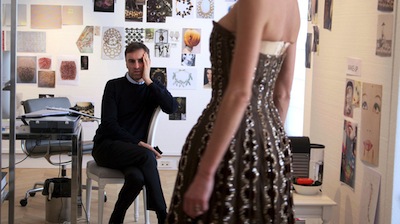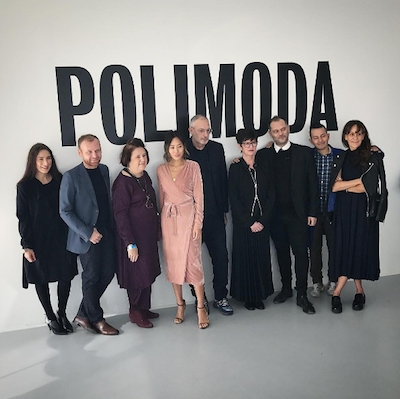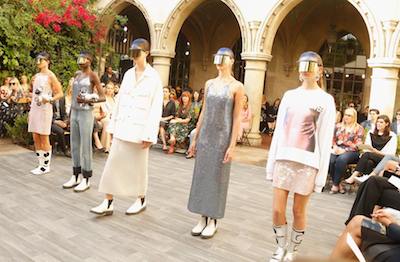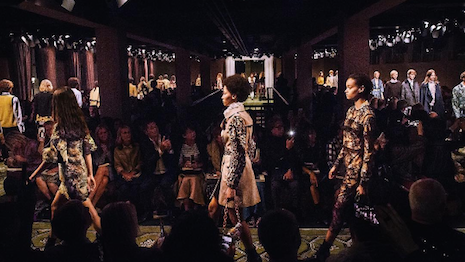NEW YORK – As the fashion industry evolves courtesy of technology and a changing retail environment, education needs to evolve with it, according to panelists speaking at Polimoda’s “Fashion Displacement” discussion on Nov. 16.
Courtesy of digital media, aspiring designers and industry hopefuls have access to information and resources even outside of the traditional fashion school environment, allowing some to build success years before they would be entering college. However, even with this possibility of early achievement, the speakers stressed the continued importance of the education that fashion schools can impart, providing designers with a maturity and background that will enable sustainable careers.
"If we reflect back on what [fashion students] really learn, ultimately it’s about discovering yourself being separate from everything that’s happening out in the industry, and not worrying about how they’re going to fit into that cycle immediately," said Burak Cakmak, dean of fashion at Parsons School of Design.
"So first and foremost, we need to ensure that they’re understanding who they are, really looking at the blue sky ideas, learning new techniques, but more than anything it’s about the community that they are a part of," he said. "So everyday you’re connecting them with new ideas, new people, new ways of doing things.
"So it’s not necessarily about the exsiting cycle, but looking at what are new ways and new cycles that can be created out of that journey. It’s critical in the four years."
Star power
Suzy Menkes, editor of International Vogue, said that she has witnessed the trend of luxury houses scooping up young designers as far back as 20 years ago or more. For these historic brands, these emerging talents were a means to create a newness.
However, once these young stars had been within the organization for awhile, brands began to realize that they could accomplish this modernity themselves. As a result, the long-term relationship between house and creative director, as seen with Karl Lagerfeld and Fendi, is no more, with tenures becoming shorter and shorter.

Raf Simons' three and a half year stretch at Dior was just one of the recent short tenures at major fashion houses
Ms. Menkes also noted her concern that these designers, many of whom are in their 20s, are being overworked. Their responsibilities, including what might be 12 collections a year as well as maintaining their own label, leaves them with little downtime.
Blogger Aimee Song, who boasts more than 4 million Instagram followers, said that brands will have to decide whether they want to listen to consumers and maintain this endless cycle, or if they would rather keep the integrity of their designs.
Julie Gilhart, a fashion consultant and the former senior vice president/fashion director at Barneys New York, said that brands, particularly large houses, often look to data to dictate strategy. However, she argued that the companies that are successful are those that are led by gut feeling, pointing to the successes when buying for Barneys that came about not from hard statistics, but from intuition.
One of those labels that is guided by gut is Gypsy Sport. Rio Uribe, the founder/creative director has received awards for his diverse, inclusive designs, but he said that his activism was accidental, as he just stayed true to himself and tried to find a place within the industry while casting friends in his shows.
The balance between creative schooling and business background also came up, as panelists noted that there probably should be more of a balance in coursework, but also stated that schools are generally not there yet.
"You have the tendency to find convergence between different industries, between different job profiles, so we ask brand managers to be creative and not accountants, and we ask designers to be also entrepreneurs and do everything by their own," said Danilo Venturi, director of Polimoda.
"It’s something happening in society everywhere," he said. "It’s like when you have magazines who want to be educators and they start courses and you have fashion schools doing magazines—it’s convergence. And the same is happening in the school programs. You teach to some profiles to be this and that.
"And then whenever you have convergence, you have also divergence. The course that is best performing in terms of fashion education industry is called collection design. It means that people apply for a master course where they learn to make a collection, which is very narrow, very specific, very divergent. It means that we teach them to do everything but they didn’t learn what they have to do.
"This is a statement—sometimes the very old is the new thing, because we forgot about it."
Many of the thousands of students entering fashion colleges wanting to be a star designer, but for many this will not come to be. Mr. Venturi said that it is an educator’s role to help students become who they are, whether that is a celebrity designer or someone who fills another role in the industry.

Panelists, from left: CFDA's Sara Kozlowski, Parsons' Burak Cakmak, International Vogue's Suzy Menkes, blogger Aimee Song, Central Saint Martins' Fabio Piras, moderator Linda Loppa, Polimoda's Danilo Venturi, Gypsy Sport's Rio Uribe and consultant Julie Gilhart
Panelists also discussed the fashion industry’s relationship with education.
Fabio Piras, MA fashion course director at Central Saint Martins, said that brands miss out on opportunities to work with schools. Partnerships, including sponsorships, are vital to the continued existence of courses.
He also noted that it is educators’ job to alert the industry to the fact of prospective students who do not have access to college because of the cost. Without sponsoring talented individuals’ schooling, fashion may miss out on their additions to the industry.
Changing commerce
See-now, buy-now is a trend sweeping across the industry, making headlines for both adopters and dissenters of the model.
Earlier this year, the Council of Fashion Designers of America released a report about the role of New York Fashion Week, which spotlighted the industry-wide agreement on a need for change.
In the report, conducted in partnership with Boston Consulting Group, the CFDA does not endorse a single solution, but rather lays out a number of possible answers identified by designers, media and retailers (see story).
The CFDA’s director of education & professional development Sara Kozlowski said that the report’s results frustrated some, since it left the ideal solution open for brands to decide.

Runway show looks by Adam Selman as part of the CFDA/Vogue Fashion Fund
Fashion shows as a marketing or media vehicle are being challenged. The sheer number of events during each of the global fashion weeks means that editors and even influencers such as Ms. Song cannot possibly attend every show.
From a media perspective, Ms. Menkes said that sometimes showroom visits can be more effective than a runway show. For instance, a designer may be able to communicate what makes them unique more easily in a conversation than with a parade of models.
Mr. Uribe said that while he had success getting noticed with runway shows when he was starting out, he has seen friends in the industry switch to more intimate presentations.
Naturally, social media has stepped in as a means for designers to get noticed, however the desire for Instagram content has also prompted brands to want to do shows. On the same side, digital media means consumers do not have to wait for a magazine to come out to tell them what to buy.
Mr. Cakmak said that fandom for a brand on Instagram does not happen overnight, but rather through continued interaction.
With the election results in, and a president-elect that has said he does not believe in climate change, one attendee asked the panel about the fashion industry’s responsibility in sustainability.
Ms. Gilhart said that she brings the issue up to every brand she meets with. She believes that since fashion is an industry centered on change, the players within will be open and active on the cause as long as they are given a slight nudge.
"I would love for fashion to be a platform that includes everybody," Ms. Gilhart said. "And it’s such a big business and it touches everyone everywhere, and I think if we can use that as a tool to empower people, to make the environment better, to do all those things that we need to do to make the world a better place, let’s use it."
{"ct":"YgfC3XbSYwAvmXVb1ooCEbENj2mfGdLHKwRQ7axn01mQtm+Ued21CxNd+gtKi6ZIgPIa4B+ygDSkECSwEDEOj6yW1+uKNOphSzP9V\/6ir3CtqUAaA63+WI8GFm+JAhv+p8daf5uZB140l3ZwjQSjQ1ZUPcnwk4S80W3+t1P3cKRXMr2Pp5tVBKRYZYa1mzoij0+YTtYJ6AhYLHSeIkkusHa95INFYmAAPCm1DEIbPbY4naEloUmWN2sCRRd8\/4OXhGozojLAYwhFqKu7dxcQnHw8anbN8W9gD3d3xyed5I0QvYypKznHWdJM26PYY5lToxDnsEiH4NC5ftJ7XKMqg3L+YzrIw1k5BiGJl6wBybkLEXF9OABrOeyfME0pWQySBx3Di9QDW4gkuInjf1WIA9fz6cJIqy9eLc+817qWx6PH3e9D9PR1V2IJds6lVKqNSQLiBjzHzPgLhhdLNrT4acoVxEVJvftKse73CHgL1v6Q4QPfzhCHL9K2EDuyf9hNJwThHyRzJ+1QH61tPJnlY2S+C1pP8rb\/12NK6Hl7SuCp43EV0SRMlU9RO0bGzn22oEG7ih5B+RkCDdNXm6Jv492LRLu10b\/L6RSgqmCtMGftV8+28Ed2gLOt9PHxLwZFTiZ\/ie6P1WeP7w8yiye\/dF8coi6dULxKGuJHxqYLidlOxaLeI+xNsX0o8sV4uG4g3QXG\/zC1qresbMPM28aJOArvtMY0OnzTRNN5D2GO1ypRFEgNoP4j5KMMmHCcdTzzx712Fqfhl71sC3CvN0FB+ONQdNr+6Hj9aRgz6Uf6R29sVnNJjObycQHE9Bw4hYQq6YYRIwKVGExLXCeYi66e7YvH6B5w0YoVIJe9nF4Na8E7M1WBBrgjvgCuFHtqLJPS39hTI3oGdkcSWRoan1sLGxhvRTQe9Jz\/fypspjsPkZhn97eUnkfDBP1gaoHdYzVsPcQ3UrE4EwqHaa2ALc0RxMIUdAQ61QwrxQeVfeFj4mcA\/NKs7OBP1IuokZyWpu3\/QD\/A3TFEe52cKO0e0h17w7zdPeslITMuXayD9poIkiSMQcOADKm8OPAxFlHeWHjZUU1wKMiJttxpIt5iEjj0wJRkDFc8CS2LQ3fskV8GrholnLVFgh1PeV2KTHthWcG8YG6kChKk2susivplHstHLcBIOX8M2uq3RXnxDqMD2\/Uy2uTP86rZMErd4VjI0js4YlP5MIuTFtIYgsGuIaJD0rIAaSywadsDcnvX2LZMYdTOaQmsQwL6RWmsfIIuV3OZjMNzEyZ80+iaRWgR+Jazrfrum5x3Y1BjAMJvjz5hSLjK8E6Ld3e0TJixZ\/6llnwOcpXfFKZ6Sp+wT2gGdr80TLEwH+sGnVCQxf8iF00uzRXHHs0mMHIZUd8ZlLtEgSL2CQK7xvcKmpl0lPUrFw4UUM3fW6Ltfahf9oc\/XX10zaBjPN\/3PPSv0z\/i2QClwGRf8DoaF1j14PEXcyAh3yEPjQNc\/Q3iv4KORiXs+jFd+EHQGxVTHUuvxziQmsHdWDL25X3asJ9WYciGhOQxfWA2l8DGoodL5HSAVgpMmAPh3XiU0veFP6iGtyDvQi4qAomYKYFWZO2T5Zo15oPcIC6sEKO+4i15KVLGe3ZkzF5+9IjpDim2uiOmJnSReuyBAi0Rygul3kX8Wc\/4FAOwt6YEjTU\/yg59IO+a29XYPEOUFm7Ckmq4KxojAP5XUOQOxmI6bzV9Om6sjzKbOueSEllAJgES3Sfa4xPEZBjsfAfoYUHhqWcG+bjDVGlPZGvvV\/uJOqlv7BuV1kagYrO2mnDVlFiuV8\/X16KEZY3FQEKFAfgL7n1oxJdX9adA6h2+vML6FiuDCZiCTI25sFAt8j8ta4gzXQtgH3cA\/onKy4degYI9yiVmJ\/bWlOtu16G\/tDuS3re6IsqieqPgQPStwcz6\/CofWjzBBYhL4QV48TXg8eG26kojF1DZZRDoQqtZWYC5sKYNi6OEb4nJsxO9bz1b4\/9PHE0nx3qiUGIaAw\/vFUSi2qltaY4KhyOc+sch0YskvT+B39v6VAix\/fiFtgBUQHK3\/ddpddR99HwbNk4FWhh3NKFXMD9KjgsmBunFRDK9p4cuWz1hb8T3UTmO2lbRQImLyRW+FS52cpCRyVD3T54elb+ADHhjPobTe3PRVUJiv5Uglu5wIzf9opyXDnGdYJmMQlygPQk3U324LZugW8g+lejzsLEMeKLoi5bWgE2ohledke9nB\/Z9cLPZCx6Jv9j5TiCdpVQR78FYRmqoOgxy3XKC\/wmys5CXR23qT4dvBgAkDp+l2hUi+vX+AWwEJN8AFSU\/U9tlu4r6aK3zwc+Nj4c7urlPZXaPP7iGPazNImRLcLWa8KPO7hnnVs1CokrsYGNZTMftjBreRKkLi5VWaM9\/uozMxdw5cS4j0StmYBmtpRsB8UIeEzsXSB\/efuZm1NkwjwYdK88\/NTcK++AQ9NbnKWH0rAmStHEhbVHzfflqIwng+QGI1yXIGVHQi8wCNJfg10kX6xuJAGi46T9ImA+\/M5rSEWH\/suxfC03VavEYAv46Pdr6WtQ\/zGSCMJEa8ydCv3EIEckquPzqN\/voadsTaYj7FgUf0gGMQSx1aNZTmu6+eWJ59neUKzPfonOexYPv6U6rZgOum6EM2slJYOAmTNZ\/6fX\/Z1UfrdYPSf1ssD\/dEwagh+oz4ICFoJiKXU8wy0AXK+yTZuKTBag3NLj6B4r9KbDRqfRAnsqKXej4e5dcmX6DCkVj1IPRC7XQjHuyDDlYOotgtlRl2DNmM7\/CxgPo7PpfXur5RZehQFcN2PfSaljIMQcxSX5mM5dT5JvZ13tlMVLz47m1se3CJMenFANpcpNsd7QRuo0R4\/IpoTvOL4MLyQAZpZC6XTsCYsgbnGDzUcIjSdG1FmyVT0JxI612fJ6qILQorPv889R7ilcIqzkXX+angxM+T0QhJVH+5aAiTI9QxhnX5+AF+EkJgfoehDBjOfcfTZiVThn8w7VtnmuvIRIyMGyP4rl3Gw0vg\/pS\/yjK9\/HVZW\/3L541Uz4ruwc7Jhq+I5tCWpcrRuAv9A8cHmwAgjfs\/n6PUTegPHFvGblxNM6qsdkh3fOUAVomoI9UNI3yyshQKQmtlSLVcnVvBgi9nu5Sj2G\/MR912Ljgf+w0blG\/8t2oV5D4nn0o\/YmGfLGLB\/eGL5wE9Z0A6MEeB9EOOiyfX1BX5+6xF4jbxqUtrKlfKJWVsy\/Hqa8uea\/xN9ij3kmxGEU4KvrKXxLD6lS4ONRkGANo07hhxBO+\/2T2f0I22hKrEtfpO1bQv0QJqW8TU2FK5POXqEO80vCoX8zMW5fr1Awgyh9F70su2QXSjLP07g\/izsMwfGdXlGRxwRBeqO8SSFMd0KPE9dyOO7jJazfIDCZTn7WvC8sG8kr\/oLaAXESAHvAzDzwaOxUA8bYNDzeJ8\/GMAqLKD0WBe\/9lzJwJAS7SRVVb\/bFcl8pSbW0DFIK64VKQPId\/OzqQNbD1mBoQlSGcwMxtVZL8bcx2yOgUTID3xvXqF91I79xX0tfWGeUnKe29JqmV6sP2Oa0B0Kgf3mrARgzUL4UY4PlvJaJw8QFLBRv\/oM\/PQhzieefnQSi88Ki9lig91RrykFO04oNzC5bYDQKBWTrsEdBKz1VB4f+X8sdewb8WVBxeQOu9MQDT2Z5P7oPWuIesf22sEJLLr7qNpLMRLTl1nzCWLz9\/UHhzBBzbldNUSz6RLX8a6oj+3ssvNeE8mzMlAK6ZH4K7CjWICH8URjSWygW6ftbUTVCpYFpFlnHmPoJoDygly+F3S1tGQiS838L4xS3oRlc10KlsGFIsEW41e1CP0IU31clruBPpR+4th8ZglZigERo6x+4UJQoIG8nBaHjIZbPgGxMvLHnwpURuv0biQUWlwJX2dMF\/\/yKdUxVMe56IBSuGcDU3Kl99BKXuzT0J00dmWfkFzkrqaoOWC96EeL98cXxsq1aNILsu43DsXAL6oKtDLCzNlWT1B28sga+GCvQMMRElEa\/fzbHylAwHFbKjKxPc98Ulx+029X9DJLaWupew3YvWsPPW8vbZEtgjPspsqMplg\/xnW6c4FJxP1ieekeDLqTE7WaB362c4JiUlJ1\/hF618ZLBZB4iWGR2V\/DlG5B2a5igWUgzIF21bwRpg5q\/sS4iYMFRgZPUwv+dpB6FLxUH9S7dxMfIfOQf+ySTGMHOdufalNIsJdCbSNmM2D3Pl54lD9bYf0cD9vcCZO9mpaXIZSu8vO9O2oV7206KByeKiLBQePA7yTY5FDAvF8v7e7cgEBevGzaRce0TVPnl8Ti8PFOGLzH46CXVwyFHX4+LvgCfGnsixzS4PSF36HIiGCd85hT7jTGxMI0MoVntjIbpNZgQdyNJA2S1kekSWaCV6FhQvxNPi5Vmn2gq2m\/h+HJV3Z2voi1bPEIiUvrh4DUtDHImFyRC9+acPIywJT2YmjD+e4OYMD1YXw\/Y4lJxEURidUi719JSksjOwEJ11eRTLT7rI2PhLNeNP2Uamk2Ocj92tspUCKosk3uHK4oVIBi8yH3yaKkdr\/PsljgCfGzAbQv4Ky66xFJgGgugRaHmM\/hTASdphfhudd2FF6VKKoLn\/\/mBU09Q53HQV4vtagf3jpBONJput68ueBVrWAOHouhzFCxkbO6oNjrtT+RoFGNP2TGykbefmPvzW+WAdO8Nx7DXtKhcgV2aCGCPz6jJ2ADWTBWaIGdDTA98AWvS4qRKtCVMntY\/TVxNveojkkWW1gp+uvbC8ZQH7z9xLPBLjNO4bWbbn1mpOZpXfom63vrHfQ4\/cf0ndvVCfY+OC0+Msh5hzRXN7KdV+0RX4Aw0MVQMbkahhvFfpsceoqmSmdEN9jvnkSP\/ishlxUodDmxXr2tLDu40+FOdYR2taxGKCLDQsDjB7azrH5wuNse9JCkiGFHL1myRWWDynbIXoDJM6vCvyCbsGvehCI7vTPxLoJGas1G+NFeqXcK33m7bk12gkL4uTY4R6gaPj0wFqjTU6CmXlm29dKg\/6dK3O+i21oObatMPEMkQIXdkcKszxTnLjJ0X3ip5PNTQW\/7iYZbaYgFTAgIG19h0Fh0ecRun1X5PJMxUk96GR\/RGoew0D1juros76YhoM85yaGDgI2UrcgnzuwW4OovQ9a27QmDKDTUzni7yjJdgr0O00v+kVVqSV2jJ+AXDms5LjQtAuJwyqNEdSEobZrPNejZWhc7vt55s7hP90x84pzoJdunaXBE0JdE6hd9dK3xl1goigjmNDXJTddzjAyjdDNISMlFLDe74oPZ++Em974sh8LwLZgB7hJQHqjyGRMPQTOzaR8592FE9UG5VLLE0tPVfL192T7M8USSh+\/omenK1ftb+PyL2O8MWRw5I7B2PGFUojpzq+EyvFBqlsJ4lHL3dPBKlxh4eyPxzgZGJsn6fW2c4fI2bPjQRjWuw3ilFLUtDT7\/SIzaTUZI\/6nvvO49jevHlBLPef1O\/YgKh2FL2AWo8zOtfarn6Uy\/4n3hAE0ONJ5CAaiOxQxPmzqeIn6nca4gelOiXyeBGyctSKVLb3ZZCIMIXOi8U3nJQHDAw1Oh4Y6EgafIxkavhZmtcPxHDYzIlTXaVe\/Tz\/e5o6EhSp2mvURI\/NlCI4u0RjCfv1tvnCVrellPCvzXi\/xcAovM0a6vxf8o9+CahneTMFkswqDS9B6FOyjiYRn13FxREFIHIxRaJbrjh0y6ved7hhbQCHEYEd03fhLaIaELgitgnp9Aem8Jlz62MVGB75Yz1iROYyAypUEkBSLY1C8PGjLwixkybpM0V9tsVV8WMPtErTcmkjIASvqJccdoy6R3eCDyshchOT5eG8WVuURTYS7ESA52mRSF\/nytpyt5eGfCNsZ8ZbU0nk\/b15qt4LCa8OPts1yf\/z0jZGr7BikZLTJfNKu\/y4AMtbckDS+sgCgoCN0VL2+O8DNvvRSsZEmeWtuDyEG9CLFnYw65LyUMpvfirQFuFGecL5gL0VeJ3BilYSDjpP4BqgC2hQYbL86gg8JACkFKGdl3ETugQ1ilORyEylmgJLbfO0AY4dsthZXdkYODaSQZKrF6EDPCQdQKXUZAPf7r9ffdtkOgKhpgXGYP6Iws2RA9dDGwbxOqmZpiD\/a2HsWggbLIwOcp1agTlCWhJjxO8zEu0lWlOHsPDlg2rQTdkdqZfBOFBgwKGMqALydsS7oUTwekgx3DT3Ms6gW\/tws0lG8mzZ6pvtt+30BR43kP\/oRisvITj8dCULiilbUYhBE6LKVX1KnfVuS7jy5TPBqmMXfgwWVHQvhF6Aw3I\/PSlSJSua8ZLy\/0x1G0gI4srAqL418B5BMfnJnRYLGEzlzeJqQsLSwSz6KEPTOZY090w87lbKLhOeiOPFAhO0tAI7WKanaVwiDBse1abebpN+bemFTYs0Hm0ObTrA38afS7UaVGx1qnv0GF95y\/fBw4EtpFUsKO3WM1JKjZkJylwdtrz7cI+S4XqcBezQ6fIUDVcSVzqiIRfqmIP+wdVcmlACLGFY1DvMBRkr5IMZLvZ3LTu4ySyhjiyaIcMgSg6EJeS\/fsDeBwhxHEjEMSD81KHSpWTZOu5SrUqq7Xa6lG11TVcGZibkZXEWwhYVr5jTGFX5oBpLuX7L+toRQ64E0fbXg29LP4rHpiUni5fBX5g6YpbGHjD4F9aAjfVIb8ipbLfiEYtfM1n11VKR\/KAQygNJ\/cJ4Ls\/Kw0UvEPYVQ6mP5gp15jJ9uqCMEqm7vfADBNyf3msFyjaDqZZwormej2e2qC1ahXXOK5tzGjhtQCovkoNAkJBkMNWphPYk7jNvr\/nyLG5Su1\/Tu3stAo5aBdGGisAPmKN0kWOACk3BvyyT1NE3SLEIQ76s\/T0tsOS3VB8Ynk8PwHhaGXjgipjlQ\/6gZN1FoR2gfWAjNOROlYeE5TBgysDF+\/jGIZx+SL9KJZngEDGjp3LmBYIahVUPnk7C1H9PmgJIRgbdNSM2goJcXqbTg3iWvTwhm8UPTgZRxUC006\/Ex\/kNfiGyYuts8nnwXOo1sRL2MmL3vCD0kghSX51W+uqMUhnq3Uc7vC6Vp1psZuWGDLw3wYGO64tW2L7ms00wcqnjew0oZa5UER9QB3vv0J\/lQfoifKAlk5+RETLYiFBmg2zhpoeGYfc7qhlZ5PcyGB68H2IiZ+nKOly2+2h0qmNvzBLiHzyeHyk1FvYd4meaHeRFg+ED2rOKVZ82VMaqTQhWRxHopY6+saBjTHh7+oWKpwaf3+KzY3kKpSLgeWPRZ9+z8mTfOSxDJddH3I5o1YX3gHH2W1CGLyRkbUHdZFsYNCVTZVgrdEqdab6PLndYBYXJSMBJV9k7UVXBNiSgylVdHhDkVldx6zqPPU3cfP+6pYB8JgfkUrTDwWIGTF9hbttWMolqBbO5gB8V74tgKZbCKVemN\/bjNsXm4bqOe+wgRS9UX+8YdEdMZKsXA8AZpaj9U\/ACZG2W7F+fjn3n+nhM4QWnusLPY9ovYhxQUGAOf8w+lBGgCobis24UI+eLg5beiYOe2Dz6nFuwJEQ5zpaP0tEin4MdDKLbIURuvV8Yx5quz5iXyw5dAjYJXpWlt3Z8Z4XgdAqfx9S\/UztRqHnz3ehxSAHbkshuCiaEgL63IWzQcEUeDx59jQcvYj\/amtqUNPpbM3XjtB0\/AvfwKhtDYmP6sF4O+Wp6z7o6dp56LVutF4utIGLguWgld26GaVd2dXkjk2tuBiLnQIUXhSa\/wf1SRBMAIr8R7lAHSZ4sJPcqqv0RA5hQd1h\/vL3rI6xkQ0YB1X0l8mMDifS9sSbFZC0BqVBiQZBH9vr0oi0+pm2QCVujql1PG5C9ZnfHjXheMk5YMQe+2JXuTjjXz+V2SgnUcgyXZnkQMX8Q4nIMiQIxn\/JP6CQtL4U+cvfc2O2IKXBefa2IPc5wa1hWbmCRi03wwIWyBoRRxPhlkf0CFmI86OKf+10GpvBWH8RRiQSd4QiFc96EKGr9bhHCoXb8XgA\/Iq2IsU1Cjr5T6jxxfiyw8jLPCTqKyrwU1evJPbQ8w\/nBGKz8HXO47h4Kgi6JgizXyUFT8O63gM51+FUVQe9Pp9tH1f91zK7Shox7\/aXidtW\/GUDHEPclcSgOrkP6yqKZrZlHSnieQDS1Zyzb1MP9uRSPN8L2uVk3EaQGw5wh4C5bsDn3MBDMwVu8z\/w8DMkYTULViKNvcwAvLzSb54msk7zIXo78iwZE2F3l80NzPdq7nFF7\/ybuwzbtU+4epvltqaRbOV1Fngqeau20AusK4A4AWBJ49i9oTFdtTTHVh0ZJeVWAGjHXziD4s8q5mNSYDVPtH0MGqjY8X2IbmjvJlmsmITiAjbkLlUGE6OEXS9kWbU8AK+1Viykp99xVLmVH4lAWuaw2zuB2HwEhRm6oyqfoynlESUtOO5ltc0rM80hOhixfOoMBiMHjdYDnDuh3dlbezLdY17uS3B\/d7upcKEbgQUJCJaTa\/2kB8a8SOOdcVupaPpsLwe29MuW6QvpyNf\/8blXDhifdzW0MjhdgC4k5oyN07V6FJVB4+InlnQNWZzZ9oykoNKKZZOrvqKKVpspuTZOczKtQzD6xX5BPxrosI9HuxGHLXG21WCYTcZ6PdBRNEg18U\/PRIwLW6jb3hgRgiFWVXOF4PNcBzXw2LVkxOyvggbBPR15IO\/VMKJ8\/cpeDcLVXe91Z4A96Kf9wqSj4fAvLUmSe2213PEhnYgtnuG0LfSf6yyyhbD4xnHbdFsFQfKgLUm\/ZTXqBeR4LPLR3bqIyfwrXUm+x8G4iZbTNF7utUhUknl6iO+cOvNp2z6w4f8U5maGu+OuhDcqoy9cNCb3yRV0OKcFz0dKZVLskG1pvPv+bJDd+R\/MMaWkBiD3CDWYjvvq+J\/cujfC1qyKiFES6GM+3mGD9hepuouqGMP64+B+tlENRbN47s8sofn7oMmKxfFtvV5jKkrMkbC+Xgpcv0iozDvEFrecgSb\/8sQakvfLjCNueVkMJ6LJtyh\/AWhnBiHFdtHVNx+DvgSSn9+DvxjRb7c36ogGFsG+D77qI\/4eIjltypg3dhKPBbAQvfAPWUUTd7zf+UbZ6xeF1\/mWiZhh\/zVuDOIZYEDIgvrFWiQRxmASvdXZRG+AZLTOmMkiViUwqFZllE+hByfysqy8SAyv4EuY5qYKJqgeF5189T3N2xVumm8FdOSHpV45rduzS44u5IHl6pKWFxLfYYzBM9fU1zKzKOWFLTuzTEw6aLUEyBO2AV8KGZaOojjLvKMcWe\/IazLkJBw99OVr5xI1cWJ1o3gff\/oCRzTKzU3MbBMyW7sUs7lM3lb4ewZFvd7lmSFsvYXyEJsvZn\/auwHAO3iNXN5q5XvUFEJG7G6QRFbbmgRP+lHrnDGXHXzSSpE8QhJhZOd0AUXr75ok6gIzG9Fp7t3USugPcz+He+J97X2JpFaf05UJPSMj4jHtWYiUDc99yDbZMyM6+u66DMRgWbv3PfGmHV2C5Zm6EjUIUQrq6Yo7en5DmZQOhx7A2pe8N+VDULu2qjwTpgJh82Rt+9tE8b\/1HEsFT7R1T6Bi7tVTRHeegGjz17buyFaVpBQDwK94x2+rBgGAw5e71Qrxbi8m8ZSBntS4FCcN6DRns02yZz0rwpxHsslfTrH8fRAS5sqiOrPYaUOVPCpBScJjrscpgPMcuLB93q8pGg0V93lcMZmqNMg80Q6i3sKwZEBFg\/1gvzqaorfLdC0+A+BouaMDV4TLiB6dPzhu\/zsYgwpvxI7ZIISYyxcW8pAliGpMEeAyWVmB2sKYg2TB07cFnlVzyeuRtlkvttuU16uJhnJtefQ8s75TcydmlDgsofqfpNzBq0dZwRvzVH4jf9eiP\/O27Ln9apkOD5vd6XZC0DCj9wZJJ1UuilMdkbdT8ckJGtc39fFQ2En9nSZ0ZpnDeoFRTMAVZmPOshubBFASTG2ayVcRzXeNeB82VHt4p9O42c4RO2mEeGMuYfLC5dmWkJszmQrx7qSKIJng1NFcPg79NFfqaGcVeZ9krJOdjLX5XW3ekC7rFkqpxTf7nQApqZFoKgzJFfKpJ+CJoVtLzO9PKpHf49Dm22mi0M2h3CAAzknZHW85N8VYlC6F6kfUd6m0PmhTNpbSZS4t1f6z9DYhPUpVRy7eRwnsAfmbqaVPpk90vvn9AX5MB84Lg+9hqAzbE5gAv8a6LwWeUXAlvf9iJDfm6C+3w54hbGvVxsWWKB2irpbiF6pMl+UhhW1KBu73H85A2RRBXBprv6TPUxAGBEDKkH7D21CC0DUdFg2YBz1zZcqgTsVMyoAkbTSfnbFy6kWqEDOWHGiOJ5THlZZlGTPhUr4fmFs+kydq8QtEpUI5485fBGg9MdNvqp+4zu1LMkZemX1S+ZsepJ4fVSwWE5QbUxGXXWK3DF0A3vjuv27BB\/rs9H\/hZ41qqc+CfO5nB6IT8VfM0+K9UkZhmcDQD2FEF+pqZLf2LE2Ueaz+t01\/oRlMnVsfFl+0ZKf4VdRyIx2OX\/l0QV\/8TTbOyae3t38OpKnGz+6tDUbsMkpQ2sQgJ0YlTDELn4Bd1GJpFKfWKsbaok0rNrfTC4KzzpXOTEdfucC+8eFnZPptwoooCBlSSNr\/5gTHCc+X\/0LTl\/qTIfTNP8GUQucoMwyZyFjhL2+pCKrN6uh82HFxHEvPgJMyOGo9NIal+mmiB9gF+ROrBRPioOHfWIFyGJAgegEkTbKTL4cP\/ewFVa9nd\/q+tHyH3rxMKGIWOvBiiyLJ2AVK+sSp0mrnBmI7YfZ9CmuQQPz\/1IKl3AHy\/f9d153oWTI5Q8MUTNYmD1H2GQQRS9dP9MMsxp8Vb\/x1LjDfsxa\/mHyVM\/oyy8QWEeN+NNS1La\/9jbOFIE2QAQ9OABGdc7V+Jcb6vsccEZ2dcfLNbuwRpBBbsWHP7lJ1XpRjeLQZ75PSQVVLUkBODzcdHngyEXv0iUl1xbM8lQLp1HFw3wG8Zb18eGTqCEDUsT1ddtJpnIWxWvlhyGUFmOjnTP1qXMyH\/Ii1unZsjE7mpzbVa6+pm6WKHHlzjcb8A0puiySooWXs\/Rtl2pt3W92J0mn31pkcHVb3xTvvCWXl6CjRlpvqX0YVRZpblVM2Vk3kNt19t0ChM2Mu\/iz3nrgvhEiquxvRseAwrVyCw8nmGF5VMIJglkBkz9Su3vgc7V5rT6H\/O0L2kkyzqe4cVzQWMSAairtjGvQn5eYKRTd8Q4kJWqxirAZfpaZHHlh73updFG1uoyugGIazUhNzYj3q0DLJ7hF03h8yxuEWfJUzwFo48CrhoP16EVm4XANn8uVWJqwCEIVnBZZGAv0m00e\/FLyEKt7sNYXHNsaiufjuR9nRosRq37Qvhzkgt2ebeo23xcluan4X3MZVxUnxwmgP+xkNCD06VkcNiZORXgx03+8AyJDpR\/\/GWGYwfzQul4MJBZHAqg2hYyP9Hct1VGHVN1r57sQ\/6Y6DuL9epfL7PdBz7KFxJy1COj94WPlIL\/m9dwcXVfQqzbWtWoh00rX4UKY+\/cqmG9QWM1OK7+qr0On87Wju8l94oygHq0d9YWIfcXJseFJM9kopxHL0HptYiPICdJpGNYxAMYZgMR5a6dD3TQLkuy7NBbNGwIdGn57oj4z5jxPQRnQ2JLQcHoXeQVunR5MUl06jj+Qzu4HUqa42O6hQhrwboMoUdp5nQ8hn\/963S4zcE9mNKkrw0NBuTMNrmf54lIcQoa6zq7cdoofd90BAlnpk0nkm0vh\/yi2zxh07is2lB6BcBseX+ElPxo6mnSB6sg5OAJ\/6CfzD3JcpLNnrT2IcnR8LTvBj15awQJ98ji1ztfb2\/PAd7UREOXy\/K9ejAtgD\/fRo9L5qCVVI7sv6yN07rclFdDYdFbNhb0p\/Wdm7x0xLh\/4FJAWeS513LGqFp4lbMVA7C9lD7sPLVd6h5MC8aelnzUBUJb\/tnpU9f1UsvJxF3tOC1TMpD6tVmOEMAknwB9UHAn4rFzCS\/c6OkTfmbFv5ut7uqdMPaVZLAJmBwauZ2xAjzDv\/NRCOknmDa1QpIKeXk3OypmRV2D2gsQ\/kp0PNOK3KjHPnRNJLNJFDYFxPlx2t8O6gt\/VAZ0xaZ4r12suNi1VzGsIiwcdvvjZGaKwpRWktefrNFpXiErqJ7Ow\/aMK7ki1TvUEjStZHdjZ+NfxnnrAzs5pm2tCz5XOyb\/DRi1eBf2xiRCgEgeiY+zBgq+aoQpqNBtY\/PmDktjiEmzI\/fgmxU5zeIUjfCC2ApGGlO3s6\/dGCSSYIycZ1PU8qon9MU7POys\/V9s68JWfV9xp4k9RnMaYTtNZ6rsOfJUiUDwzPM4f1NSB3gAghBo2bFI8XNsVWYrmUN8YpHeWJ1uy2LHefV6oyArdZA8CH1VnNC0qXEMnOMLjaFuYdD1njE2kToFAt5iZSnrxWXyUAgeflgKd4sizIHvuvUwGMml4FIhO\/co5XCzeVq45Vvb\/UgNYJLhhLji64x1I5B3fePhGhgheiCPChd1DbYTyTdeyf9YXtT0I3HmM1s58ac6V9u2uye4pQbXNO9GCx0O5ZTNfn++uMdGcQlbN1FebAImStfF4awwbU1DzGLYiSaZZxBbXbWPS+h3Voh1gj87MEoEUvYw7kD0RvUMkZreGdo0aht6c\/RAkgbwnDZwU\/\/FuNsp7K\/qnf970CLqml4AVPjNnbW27K1ZYaPYNy4W24xyJ3mH\/775WQCMdHnnIPMLPlYf+1Orcma4hJej5KCpDrtX6xHJ\/cafb+aXl7TG\/KcjvQpYox8vLtzl848QMjK6QrwPtRypJhVUhw2Ln+flpTnvycD9JjSN7TVv1\/g7S4ZM3EdqoTuDqXAha7VcVepkB91s3cXSyznWyC378FyObc3XPjjBNHJHQiIub\/at6RHFc7zgIqVi647S8OcDjLRF46+DCr6xxp52r2hUSrHXpD012jN8OLPFOXwTT8uGuRTzlXmYnSpTZgqmnK9UInfGFffVSL7yu6h7bDE8wNhiOsyoVD72cMfT0yt36eSuymvK182gQYb45jEeqNmby4sru\/92lksfTbAM2P\/TKYMG\/4+g2MNtbBFYOoRt+Uzd+aYenKyz4CPMzfw52OTxEHW17RIHZ0K4j8RbLffa+GGtem\/xtKEFnbOsWu1UQPR\/vcnUhg+eokzyA4CSVy3CepRfrxXGIqeUJ4IPwSlb+8ehXdWdUCaP+vlDu0NNCQDYfL0nFtBwz\/vp\/pYYxiCr+4CHd0w+Cu0QMRTdPjRLU6RFS92o\/HA4jHm9xJzLyl3ha9pqEOce1haCFeVdwMLqaBHaIBT5VhinVxgPM+Y3+RJ7hOLRcPcNDIfor23Qm\/YO6Gxe0Jx3JI4WmibgspIcFDsWjMxXefLYjJ6NryyWjFKXPOcJZ0KSPyxQPAoNZis11kFrFGmNazPCkfZ\/nKKWTtFpbqKJncUCVuLnNmZNNeP3An028UdVzkVp5rRHq0HUDc5gmY4qzcPjS4f5rt+gxi7XJ33K9sPrtWX6DYSR7h\/jpMwXx43eAubMyc7HIwXf6lbW43P5tcgYYUDWYscsuNBSkWDazLrgOwnaKZ4CveR5IdPIELMHZtIxxk8YPNVajD1ST75fTwy9ZONqis+I759kaUcVgHk4MhvYqbPMMCV4qpydvU9+vszLfsbKzMTzUPPCiWP4ieumWE\/xQBNTQzxehiM4jRL7Xlir17dHNiQ7WuglJjN1wNEAS6oHTO5oW6q6eT003x8mbawX7KmfJdL6CdH55ZrJeOlTD4SHxTd7lI5UNQMp42vTxSBzDu1Ml6daVvpA9U09gOUIdE0E8wE+XoVZZqO2U2\/JVp8pwdAnmvGvrCgl4zCYBTUdhTFZAuieG8wiUP4x0AEErG4SGnAkoXs4+H4+nPz3IwwxLZXtRGznm6H\/+leggfZWaChjsQz50VFZs7xze8oqg==","iv":"a478e84d5e4605ef9206de2ef0ba8841","s":"2cbdb8a30cd43630"}
